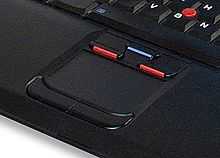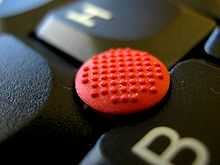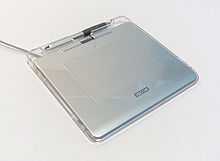Pointing device



A pointing device is an input interface (specifically a human interface device) that allows a user to input spatial (i.e., continuous and multi-dimensional) data to a computer. CAD systems and graphical user interfaces (GUI) allow the user to control and provide data to the computer using physical gestures by moving a hand-held mouse or similar device across the surface of the physical desktop and activating switches on the mouse. Movements of the pointing device are echoed on the screen by movements of the pointer (or cursor) and other visual changes. Common gestures are point and click and drag and drop.
While the most common pointing device by far is the mouse, many more devices have been developed. A "rodent" is a technical term referring to a device which generates mouse-like input. However, the term "mouse" is commonly used as a metaphor for devices that move the cursor.
For most pointing devices, Fitts's law can be used to predict the speed with which users can point at a given target position.
Common pointing devices
Based on motion of an object
Mouse
A mouse is a small handheld device pushed over a horizontal surface.
A mouse moves the graphical pointer by being slid across a smooth surface. The conventional roller-ball mouse uses a ball to create this action: the ball is in contact with two small shafts that are set at right angles to each other. As the ball moves these shafts rotate, and the rotation is measured by sensors within the mouse. The distance and direction information from the sensors is then transmitted to the computer, and the computer moves the graphical pointer on the screen by following the movements of the mouse. Another common mouse is the optical mouse. This device is very similar to the conventional mouse but uses visible or infrared light instead of a roller-ball to detect the changes in position.[1]
Mini-mouse
A Mini-mouse is a small egg-sized mouse for use with laptop computers; usually small enough for use on a free area of the laptop body itself, it is typically optical, includes a retractable cord and uses a USB port to save battery life.
Trackball
A trackball is a pointing device consisting of a ball housed in a socket containing sensors to detect rotation of the ball about two axis, similar to an upside-down mouse: as the user rolls the ball with a thumb, fingers, or palm the pointer on the screen will also move. Tracker balls are commonly used on CAD workstations for ease of use, where there may be no desk space on which to use a mouse. Some are able to clip onto the side of the keyboard and have buttons with the same functionality as mouse buttons.[2] There are also wireless trackballs which offer a wider range of ergonomic positions to the user.
Joystick
- Isotonic joysticks are handle sticks where the user can freely change the position of the stick, with more or less constant force.
- Isometric joysticks – where the user controls the stick by varying the amount of force they push with, and the position of the stick remains more or less constant. Isometric joysticks are often cited as more difficult to use due to the lack of tactile feedback provided by an actual moving joystick.
Pointing stick
A pointing stick is a pressure-sensitive small nub used like a joystick. It is usually found on laptops embedded between the 'G', 'H', and 'B' keys. It operates by sensing the force applied by the user. The corresponding "mouse" buttons are commonly placed just below the spacebar. It is also found on mice and some desktop keyboards.
Finger Tracking
A finger tracking device tracks fingers in the 3D space or close to the surface without contact with a screen. Fingers are triangulated by technologies like stereo camera, time-of-flight or laser. Good examples of finger tracking pointing devices are LM3LABS' Ubiq'window and AirStrike.
Based on touching a surface
Graphics tablet

A graphics tablet or digitizing tablet is a special tablet similar to a touchpad, but controlled with a pen or stylus that is held and used like a normal pen or pencil. The thumb usually controls the clicking via a two-way button on the top of the pen, or by tapping on the tablet's surface.
A cursor (also called a puck) is similar to a mouse, except that it has a window with cross hairs for pinpoint placement, and it can have as many as 16 buttons. A pen (also called a stylus) looks like a simple ballpoint pen but uses an electronic head instead of ink. The tablet contains electronics that enable it to detect movement of the cursor or pen and translate the movements into digital signals that it sends to the computer."[3] This is different from a mouse because each point on the tablet represents a point on the screen.
Stylus

A stylus is a small pen-shaped instrument that is used to input commands to a computer screen, mobile device or graphics tablet.
The stylus is the primary input device for personal digital assistants and smartphones that require accurate input, although devices featuring multi-touch finger-input with capacitive touchscreens are becoming more popular than stylus-driven devices in the smartphone market.
Touchpad

A touchpad or trackpad is a flat surface that can detect finger contact. It's a stationary pointing device, commonly used on laptop computers. At least one physical button normally comes with the touchpad, but the user can also generate a mouse click by tapping on the pad. Advanced features include pressure sensitivity and special gestures such as scrolling by moving one's finger along an edge.
It uses a two-layer grid of electrodes to measure finger movement: one layer has vertical electrode strips that handle vertical movement, and the other layer has horizontal electrode strips to handle horizontal movements.[4]
Touchscreen

A touchscreen is a device embedded into the screen of the TV monitor, or system LCD monitor screens of laptop computers. Users interact with the device by physically pressing items shown on the screen, either with their fingers or some helping tool.
Several technologies can be used to detect touch. Resistive and capacitive touchscreens have conductive materials embedded in the glass and detect the position of the touch by measuring changes in electric current. Infrared controllers project a grid of infrared beams inserted into the frame surrounding the monitor screen itself, and detect where an object intercepts the beams.
Modern touchscreens could be used in conjunction with stylus pointing devices, while those powered by infrared do not require physical touch, but just recognize the movement of hand and fingers in some minimum range distance from the real screen.
Touchscreens are becoming popular with the introduction of palmtop computers like those sold by the Palm, Inc. hardware manufacturer, some high range classes of laptop computers, mobile smartphones like HTC or the Apple Inc. iPhone, and the availability of standard touchscreen device drivers into the Symbian, Palm OS, Mac OS X, and Microsoft Windows operating systems.
Other devices
- A light pen is a device similar to a touch screen, but uses a special light-sensitive pen instead of the finger, which allows for more accurate screen input. As the tip of the light pen makes contact with the screen, it sends a signal back to the computer containing the coordinates of the pixels at that point. It can be used to draw on the computer screen or make menu selections, and does not require a special touch screen because it can work with any CRT display.
- light gun
- Palm mouse – held in the palm and operated with only two buttons; the movements across the screen correspond to a feather touch, and pressure increases the speed of movement.
- Footmouse – sometimes called a mole – a mouse variant for those who do not wish to or cannot use the hands or the head; instead, it provides footclicks.
- Similar to a mouse is a puck, which, rather than tracking the speed of the device, tracks the absolute position of a point on the device (typically a set of crosshairs painted on a transparent plastic tab sticking out from the top of the puck). Pucks are typically used for tracing in CAD/CAM/CAE work, and are often accessories for larger graphics tablets.
- eye tracking devices – A mouse controlled by the user's eyeball/retina movements, allowing cursor-manipulation without touch.
- Finger-mouse – An extremely small mouse controlled by two fingers only; the user can hold it in any position
- Gyroscopic mouse – A gyroscope senses the movement of the mouse as it moves through the air. Users can operate a gyroscopic mouse when they have no room for a regular mouse or must give commands while standing up. This input device needs no cleaning and can have many extra buttons, in fact, some laptops doubling as TVs come with gyroscopic mice that resemble, and double as, remotes with LCD screens built in.
- steering wheel – can be thought of as a 1D pointing device – see also steering wheel section of game controller article
- paddle – another 1D pointing device
- jog dial – another 1D pointing device
- yoke (aircraft)
- Some high-degree-of-freedom input devices
- spaceBall – 6 degrees-of-freedom controller
- discrete pointing devices
- directional pad – a very simple keyboard
- dance pad – used to point at gross locations in space with feet
- Wii Remote(/Wiimote) – pointer function with motion sensing controls on Wii
- soap mouse – a handheld, position-based pointing device based on existing wireless optical mouse technology
- laser pen – can be used in presentations as a pointing device
This article is based on material taken from the Free On-line Dictionary of Computing prior to 1 November 2008 and incorporated under the "relicensing" terms of the GFDL, version 1.3 or later.
References
| Wikimedia Commons has media related to Pointing device. |
- ↑ "mouse." FOLDOC. 19 September 2006. <http://foldoc.org/foldoc/foldoc.cgi?mouse>
- ↑ "tracker ball." FOLDOC. 19 September 2006. <http://foldoc.org/foldoc/foldoc.cgi?tracker+ball>
- ↑ "digitizing tablet." Webopedia.com. 19 September 2006. <http://www.webopedia.com/TERM/D/digitizing_tablet.html>
- ↑ "touchpad." FOLDOC. 19 September 2006. <http://foldoc.org/foldoc/foldoc.cgi?trackpad>
| ||||||||||||||||||||||